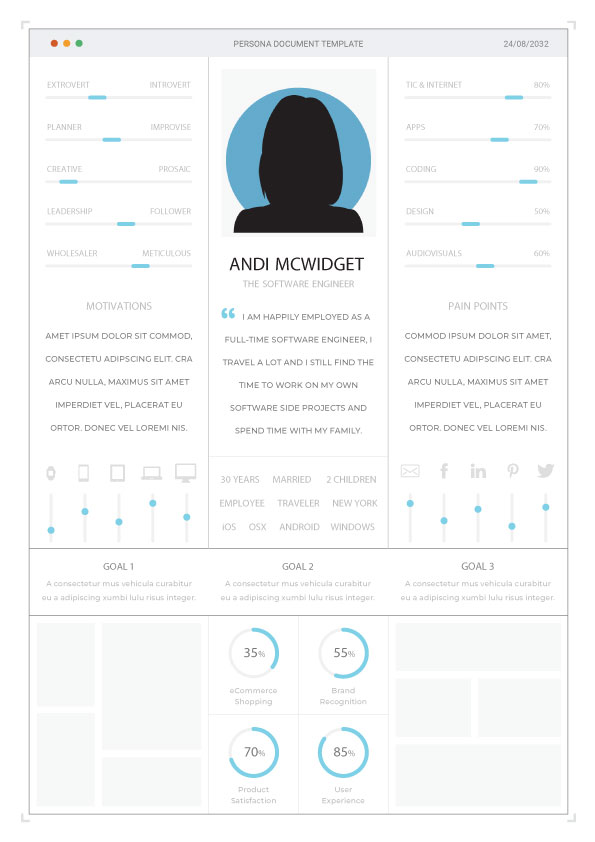By figuring out who your consumers are, you can ensure that your marketing campaigns are successful.
A customer persona represents an individual with the exact needs, wants, and characteristics of other individuals in a given segment. A customer profile can help marketers make decisions about their target audience and how to reach them. This blog post will explore a customer persona and how it allows marketers to succeed with their customers.

We’ll answer all these questions by exploring each section thoroughly. If you’re looking to improve your marketing strategy or know more about this topic, stay tuned.
What are customer personas?
Customer Personas are customised representations of your target audience that help you focus on their specific needs when creating marketing campaigns or developing products.
Through market research, customer personas create a “template” for marketers to understand their customers better. Marketers can use the template throughout the marketing process to focus on customer needs and marketing materials (content, ads, products, etc.).
While a customer is identified by demographic information in a group or segment, an individual in that group may not precisely fit the template for that group. On the other hand, a persona represents a standard set of characteristics in your target audience, including buying habits, pain points, motivation to purchase or engage with your product or service.
To create effective personas, you need to combine two types of data: 1) Demographic characteristics from research conducted on large groups of your customers 2) Psychographic profiles from interviews conducted with individuals in your existing customer database.
To create a starting point for creating your personas, you can use the following information: What is the age and gender of your customers? What are their educational levels? What is their occupation or employment status? How much money do they earn in a year? Do they have children at home? Where do your customers live geographically? When are they most likely to purchase from you (what time of day or what day of the week)? The list goes on… Once you get started, it will be easier to determine which other questions will help you provide compelling content/products/services for your audience to increase engagement.
How do they help marketing efforts?
Customer personas give marketers a focus when creating marketing content, products/services, and ad campaigns.
For marketers planning an ad campaign, personas can help understand how to best reach their audience through the placement of ads or where they should advertise (i.e. social media platforms). Marketers will use demographic information about their customers (like age & gender) to figure out which platforms are most effective for reaching them (ex: Facebook is more likely to be used by younger demographics than LinkedIn, which may be more popular among professionals).
Marketers can also think about what type of language will appeal to their audience when writing content. They might consider using specific vernacular/lingo that would interest this persona during the process (assuming it doesn’t go outside their target audience’s expectations).
Lastly, marketers can use the information from personas to create customer avatars when developing products. Personas can include details about what your customers want/need and how they believe certain product features could appeal to them (similar to customer feedback but in a more tailored format).
What are some benefits of using them?
There are many benefits to creating and implementing personas into your marketing strategy: it gives you a focus point. It reduces the risk of marketing efforts going in different directions at once. Marketers won’t be wasting time and resources trying to figure out who their users are or what type of materials would best reach them. It helps increase engagement between you and your customers by creating content and products according to what they want to see/buy, not just guessing. Plus, the language used in your marketing materials will be very clear and compelling because you already know that this is their preferred vernacular.
What should a marketer keep in mind?
While creating personas can help better understand your customers at a basic level, it isn’t always 100% accurate. While there may be generalities about your audience based on research conducted on groups – remember that every individual within those groups is unique as well. Just because someone fits into a specific demographic doesn’t mean they have all the same interests as everyone else from that group (one person’s likes/opinions don’t represent their entire group).
You can make a list of common traits amongst your customers but keep in mind that there will always be outliers. You don’t want to exclude or offend a certain demographic if they differ from what is assumed. Using language that could potentially alienate any group may have the reverse effect and drive them away instead of bringing them closer to you/your brand. It’s best not to assume anything when creating personas and stick with the facts alone.
Where do marketers find information for creating personas?
There are many online resources where you can find basic demographics about different groups: age, gender, income level, household size, etc… These aren’t going to be 100% accurate, but it’s a starting point. Businesses that have been in operation for over a year can create a customer persona based on their existing customer data. Another possible way of finding information is through social listening tools.
Conclusion:
Once you have some basic information about your customers, try creating your personas. Use the details you gathered to create an avatar representing your ideal customer (you can also include relevant user stories/scenarios if they help put yourself in their shoes). Keep these descriptions updated after you launch any new marketing campaigns or products since they constantly change with your audience.
When creating personas for your marketing strategy, it can be helpful to find out if your audience is split between genders (do more men or women use your product/service), prefer one operating system over another (if you want increased mobile app downloads, you may want to cater to Android users more than Apple customers), etc. If all your persona descriptions represent a specific gender and leave out the opposite one (or vice versa), they’re going to be less effective. Marketers can use this information in their content creation and product development for better marketing results. Many marketers create one persona that best represents most of their customers when they should try creating multiple personas with unique traits/interests. Having too many personas running around can get confusing when figuring out where to focus your marketing efforts. Still, it’s essential to ensure no one is getting ignored or turned away because they don’t see themselves included in the materials.
Please do what you do best. Contact us through the chat window, and we will create customer personas for your business.
